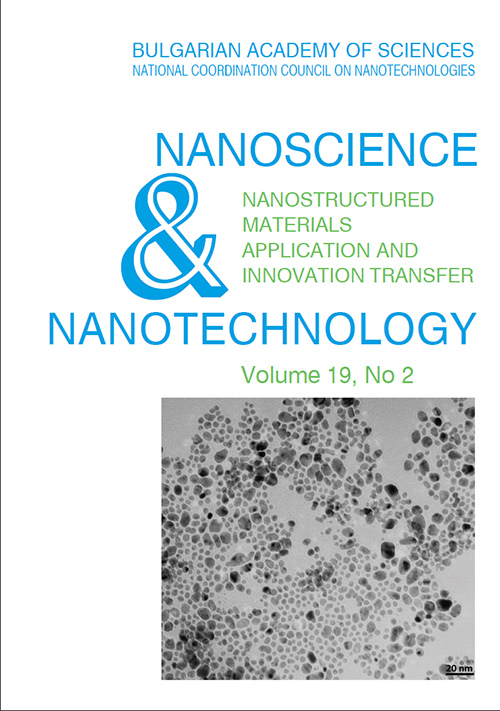November 27, 2019
Volume 19, Number 2
Pages: 1-37
PREFACE
Structure Characterization And Photodegradation Properties of Mechanochemically Synthesized Nanosized N-Doped Zr02
N.G. Kostova, M. Fabian, R. Mladenova, M. Shopska, A. Eliyas
Keywords: Zirconia, nanostructured oxide, mechanochemistry, phase transformation, photodegradation
N-doped Zr02 nanomaterials possessing heterogeneous structure were successfully prepared by a simple mechanochemical route. The physical characterization of the samples was performed using X-ray powder diffraction (XRD), UV-vis diffuse reflectance spectroscopy (DRS), Fourier transform infrared spectroscopy (FT- IR) and electron paramagnetic resonance (EPR). The observed results imply that intensive ball milling process had an effect on the transformation of Zr02 monoclinic phase into tetragonal one. The photocatalytic reactivity of the samples was investigated for the degradation of tetracycline hydrochloride (TCH) in an aqueous solution. In comparison to the nitrogen free sample, the N-doped Zr02 nanostructured photocatalyst exhibited higher photodegradation activity.
Utilization of Mono-and Disaccharides for Green Synthesis of Silver Nanoparticles
P. Vasileva, R. Georgiev
Keywords: silver nanoparticles, green synthesis, mono- and disaccharides, optimal conditions
In this work, we report a green synthetic strategy to prepare silver nanoparticles by reducing silver nitrate. The environmentally benign reaction system uses water as a solvent and either D-glucose or lactose, or maltose as a metal reducing/nanoparticle stabilizing agent. A systematic experimental study on the synthesis conditions have been made in order to determine their optimal combination for the synthesis of uniform silver nanoparticles with narrow size distribution by this green route suitable for applications in medical devices and healthcare products.
Electrochemical Studies of Zinc Electrode for Rechargeable Zinc-Air Systems
E. Mihaylova-Dimitrova, B. Burdin, E. Mladenova, B. Abrashev, M. Slavova, D. Vladikova
Keywords: Rechargeable Zn-air system, Zn-electrode, Impedance measurements, Charge/discharge cycling
This article aims at improving the zinc electrode in terms of mechanical strength and number of cycles. An optimization of the ratio ZnO/Zn and the current collector was performed. For its evaluation impedance spectroscopy was used. The obtained results show improvement of the charge/discharge cycling in comparison with the non-optimized Zn-electrode. For the first 200 cycles the system operates without capacity change. For 800 cycles the capacity decreases with 30 %.
Surface Characterization of Binary and Ternary Nanocomposites Based on Graphene Nanoplatelets and Carbon Nanotubes
Hristiana Velichkova
Keywords: polyethylene, CNT, graphene, nanocomposites
Binary and ternary polymer nanocomposites were investigated via drop shape analysis as well as streaming potential. The surface properties of high density polyethylene (HDPE) composites, based on graphene nanoplatelets (GNP) and multi-walled carbon nanotubes (MWCNT), were fully characterized via both measurement techniques. The aim of this experimental study was to determine the influence of two different fillers and mixture of them onto HDPE surface properties and their interphase interactions with the polymer.
Nanoindentation as an Adequate Tool for Studding Mechanical Properties of Cellulose Derivatives
G. Zamfirova, V. Gaydarov, J. Zhang, J.M. Zhang
Keywords: Nanoindentation, load-displacement curve, indentation hardness, cellulose derivatives
Nanoindentation methods as a part of contact mechanics are based on continuous measuring of the indentation depth at constant loading rate. The indentation apparatus records the load-displacement curves (indentation curves), which are a base for obtaining many indentation mechanical characteristics: universal hardness, Martens hardness, indentation hardness, creep behavior, indentation modulus, elastic-plastic properties etc. Now our research is focused on natural polymers, especially cellulose, including cellulose derivatives with different substituent.
Study of Microstructure of Porous Anodic Alumina Films Formed in Malonic Acid in the Wide Range of Aluminum Anodizing Voltages
K. Chernykova, I. Vrublevsky, V. Videkov, B. Tzaneva
Keywords: Porous anodic alumina, nanostructured aluminum surface, interpore distance, malonic acid, mechanical stress
In present paper the microstructure parameters of porous anodic alumina films formed by the anodizing of aluminum in the aqueous solution of malonic acid at different anodizing voltages was studied. The morphology of structured surface of aluminum film was studied using a scanning electron microscope after selective removal of anodic film. The results obtained for anodic films formed in malonic acid during anodizing in the range of 15-80 V allowed to determine that change in the interpore distance with the anodizing voltage is linear function with a slope of 1.45. The key conclusion was made that mechanical stress in anodic alumina layer is the main factor responsible for formation of the nanoporous structure of anodic alumina films.
Issue Content
Structure Characterization And Photodegradation Properties of Mechanochemically Synthesized Nanosized N-Doped Zr02
N.G. Kostova, M. Fabian, R. Mladenova, M. Shopska, A. EliyasUtilization of Mono-and Disaccharides for Green Synthesis of Silver Nanoparticles
P. Vasileva, R. GeorgievElectrochemical Studies of Zinc Electrode for Rechargeable Zinc-Air Systems
E. Mihaylova-Dimitrova, B. Burdin, E. Mladenova, B. Abrashev, M. Slavova, D. VladikovaSurface Characterization of Binary and Ternary Nanocomposites Based on Graphene Nanoplatelets and Carbon Nanotubes
Hristiana VelichkovaNanoindentation as an Adequate Tool for Studding Mechanical Properties of Cellulose Derivatives
G. Zamfirova, V. Gaydarov, J. Zhang, J.M. ZhangStudy of Microstructure of Porous Anodic Alumina Films Formed in Malonic Acid in the Wide Range of Aluminum Anodizing Voltages
K. Chernykova, I. Vrublevsky, V. Videkov, B. Tzaneva
